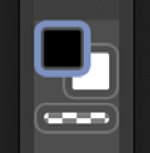Using transparent color
At the bottom of the toolbar in the Clip Studio interface are two squares that show the currently selected foreground and background colors. Below these is also a rectangle filled with a checkerboard pattern. This is shown in the screenshot on the right, underneath the foreground and background color selections:

Figure 6.8: Toolbar color swatch
The checkerboard pattern is how transparency is shown in digital art programs. Having this transparent swatch means that we can quickly turn any tool into an eraser just by changing our color selection to transparent.
This option is used to make special effects with textured erasers. The screenshot on the right shows the G-Pen tool and Soft decoration tool being used as an eraser with the transparent option to express the rain and atmosphere on the left, and the Pampas grass decoration tool is used as an eraser on the right:

Figure 6.9: Erasing by using the various drawing tools
Of course...
































































